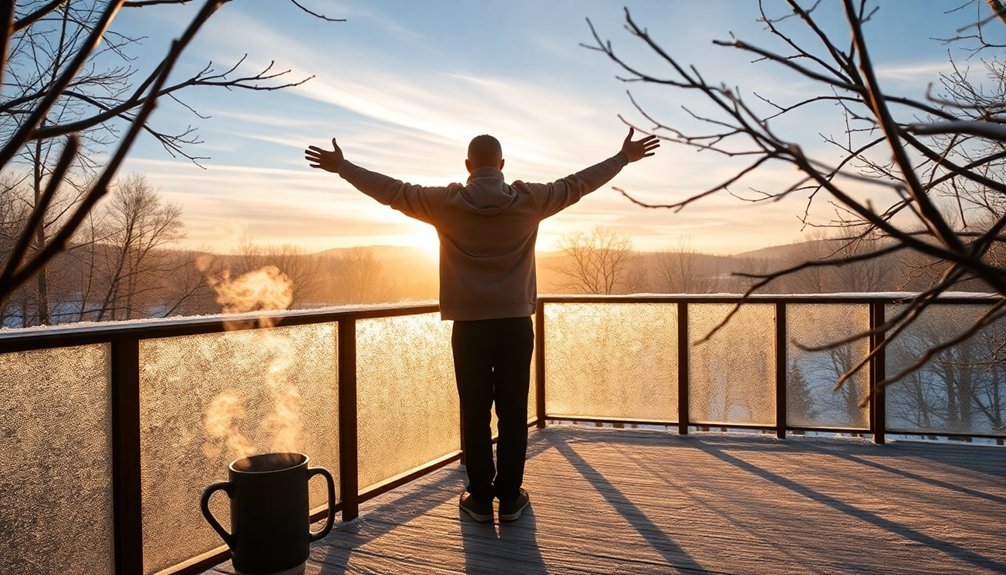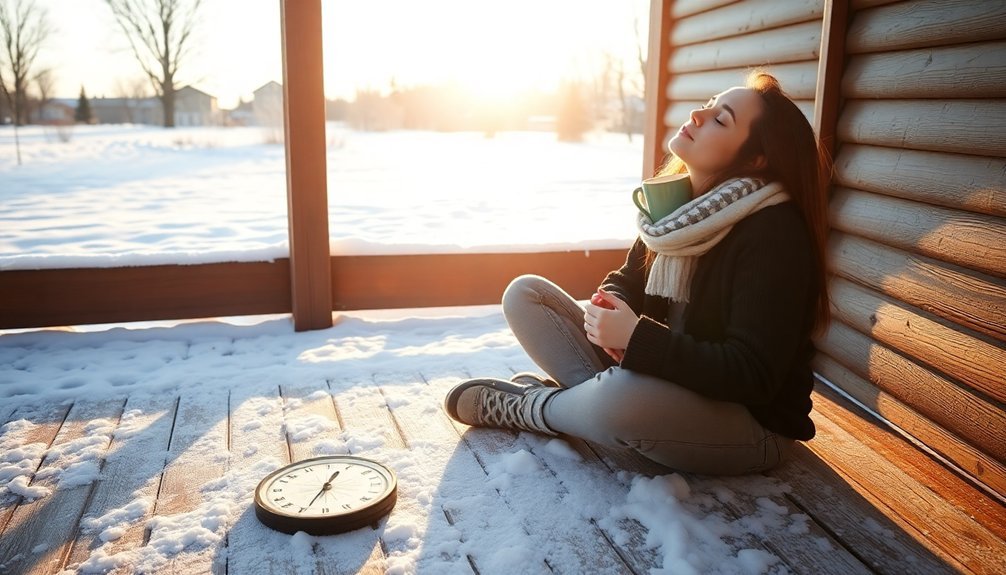Natural sunlight therapy is your most effective tool against winter depression. You'll get the best results by spending 30-45 minutes outside within two hours of waking up, even on cloudy days. Position yourself near windows during morning hours and take brisk walks to combine light exposure with exercise. This natural approach helps regulate your body's internal clock, boosts vitamin D production, and increases mood-enhancing serotonin levels. For maximum benefit, maintain a consistent daily routine and consider complementing sunlight exposure with holistic treatments like yoga and meditation. Discover how simple adjustments to your morning routine can transform your winter mood.
Understanding Winter Depression

Four key symptoms signal the onset of winter depression: persistent sadness, loss of interest in activities, chronic fatigue, and disrupted sleep patterns. You might also notice significant changes in your weight and appetite during this period.
If you're experiencing these symptoms nearly every day for at least two weeks, you could be dealing with winter depression. Many people also experience physical aches and pains without any clear underlying medical cause.
The science behind winter depression reveals how shorter daylight hours affect your brain chemistry. Your serotonin levels drop when you're exposed to less sunlight, directly impacting your mood regulation. You'll also produce more melatonin during darker months, which can make you feel unusually sleepy. Low vitamin D levels often compound these issues, as this essential nutrient helps maintain healthy serotonin activity.
Winter depression typically emerges in October and peaks during January and February, lasting about five months. You'll likely notice your symptoms worsen after daylight saving time ends.
While the exact causes aren't fully understood, research points to a complex mix of genetic and environmental factors. If you recognize these patterns, don't hesitate to seek professional help – effective treatments like light therapy, psychotherapy, and medication are available.
Light Therapy Benefits
Breaking through winter's gloom becomes easier with light therapy, a scientifically-proven treatment that mimics natural sunlight to regulate your mood and sleep patterns.
When you use a light therapy box for about 20 minutes within the first hour of waking up, you'll expose yourself to 10,000 lux of light that triggers positive chemical changes in your brain.
You'll find that light therapy works as effectively as antidepressant medications for both seasonal and non-seasonal depression, but with fewer side effects. If you're struggling with low energy levels or disrupted sleep schedules, light therapy can help restore your natural rhythms.
Research also shows promising results for other conditions, including bipolar disorder, schizophrenia, and fibromyalgia. Women in their reproductive years are particularly likely to benefit from this therapy.
For the best results, you'll want to use light therapy under your healthcare provider's guidance. They can help you choose the right light box and determine if you need to combine it with other treatments like antidepressants or psychotherapy.
While you don't need a prescription to purchase a light box, professional oversight guarantees you're using it safely and effectively, especially if you have eye problems or bipolar disorder.
Morning Sun Exposure Methods

You'll gain the most potent antidepressant effects from winter sun therapy by taking a brisk walk within two hours of waking, when your circadian system is most responsive to light.
If you can't get outside, position yourself near a window during early morning hours, as even filtered sunlight through glass can help regulate your body's natural rhythms.
Aim for 10-15 minutes of exposure to trigger your brain's serotonin release, which helps improve mood and focus.
To maximize benefits, try waking up gradually with a dawn simulator or smart lighting system that mimics natural sunrise, preparing your body for the real morning light exposure to follow.
Early Morning Walk Benefits
Starting your day with an early morning walk can be one of the most effective natural remedies for winter depression. When you expose yourself to morning sunlight during these walks, you'll boost your vitamin D levels and regulate important mood hormones that help combat Seasonal Affective Disorder (SAD).
You'll also experience an increase in serotonin levels, which directly improves your mood and reduces symptoms of depression and anxiety. The fresh air and sunshine naturally elevates your spirits while reducing overall stress levels throughout the day.
Your morning walks serve as a natural alternative to artificial light therapy, with proven benefits for reducing depression scores. The exposure to natural light helps regulate your melatonin production, leading to better sleep patterns and reduced SAD symptoms.
You'll notice decreased cortisol levels, which means less stress throughout your day.
To maximize these benefits, you'll want to dress appropriately in layers and maintain a consistent schedule. Start with shorter walks and gradually increase your duration as you build the habit.
Consider varying your routes to keep the routine engaging, and track your progress to stay motivated. If you're new to exercise, it's wise to consult your healthcare provider before starting your morning walk routine.
Sunlight Through Window Exposure
Getting enough sunlight through your windows is a powerful and convenient way to combat winter depression without leaving your home. You'll want to maximize your exposure to morning sunlight, as it's particularly effective in regulating your body's melatonin and serotonin levels, which directly impact your mood and sleep patterns.
To achieve the best possible indoor sun exposure, start by rearranging your furniture to face windows, especially in areas where you spend most of your morning time. Open your blinds and curtains fully as soon as you wake up, and consider using mirrors strategically to reflect sunlight deeper into your living space.
If glare is an issue, don't just close the blinds – instead, install high-performance window films that can filter harmful UV rays while still allowing beneficial natural light to enter.
For ideal results, combine your window sun exposure with proper indoor lighting strategies. If you're working from home, position your desk near a window, as good lighting substantially impacts productivity.
When natural light isn't sufficient, supplement with light therapy boxes that mimic outdoor light, particularly during the darker winter months.
Dawn Light Routine Tips
A well-planned dawn light routine stands at the core of effective winter depression treatment. You'll get the best results by exposing yourself to natural sunlight within 30-60 minutes of waking up.
Spend 5-10 minutes outdoors during early morning hours when infrared light is most beneficial for your body's energy production and mood regulation.
To optimize your dawn routine, you can use gradual light simulation devices that mimic natural sunrise while you sleep. These devices help regulate your circadian rhythm by gradually increasing light intensity, though you might experience earlier wake times compared to rapid dawn simulation.
If you're using bright light therapy, position yourself near a 10,000-lux light box for 30-45 minutes after waking.
Make your morning light exposure more effective by combining it with outdoor activities. You'll want to avoid screens with artificial blue light in the evening to maintain your natural sleep-wake cycle.
Remember that consistency is vital – maintain your routine even on cloudy days. By following these practices, you're supporting your body's natural rhythms and helping combat winter depression through regular exposure to morning light.
Natural Light Versus Artificial Light
When comparing natural sunlight to artificial light therapy for treating winter depression, several key differences emerge.
Natural sunlight offers a broader spectrum of light and helps regulate your body's internal clock more effectively than artificial alternatives. While you'll get more extensive benefits from natural light, including better mood regulation and sleep patterns through serotonin and melatonin modulation, it's not always readily available during winter months.
Artificial light therapy provides more controlled and consistent exposure, allowing you to maintain a regular treatment schedule regardless of weather conditions. You'll find it particularly useful if you live in higher latitudes where winter daylight is limited. However, it may not replicate all the beneficial aspects of natural sunlight's full spectrum.
You don't need to choose between the two exclusively. Research shows you can benefit from both natural and artificial light therapy, especially when combined with other treatments. While artificial light serves as a reliable backup, you should prioritize natural sunlight exposure whenever possible.
Just remember that neither option poses significant risks, though you'll want to avoid overexposure to prevent eye strain.
Complementary Holistic Treatment Options

Several holistic treatments work alongside natural sunlight to combat winter depression effectively.
Light therapy using 10,000 lux light boxes for 20-60 minutes daily has proven as effective as cognitive behavioral therapy (CBT-SAD), making it a reliable treatment since the 1980s. You can combine these approaches for enhanced results, as CBT-SAD helps identify negative thought patterns while promoting behavioral changes.
When it comes to supplements, St. John's Wort may improve SAD symptoms, especially when used with light therapy, though you'll need to be cautious about drug interactions. While melatonin might help with sleep issues and Vitamin D shows mixed results, neither serves as a standalone treatment.
You'll find additional benefits through lifestyle modifications. Regular yoga and stretching can boost your serotonin levels and release emotional tension, while meditation stimulates your pineal gland, potentially improving sleep patterns.
You can enhance your treatment by choosing complex carbohydrates over processed foods and incorporating aromatherapy for stress relief. These complementary approaches work best when integrated with your primary treatment plan, whether that's natural sunlight exposure or light therapy.
Red Light Therapy Science
Red light therapy offers a scientifically-backed approach to treating winter depression through photobiomodulation (PBM). When you receive this treatment, low-level wavelengths of light penetrate deeper into your body's tissues than visible light, stimulating increased blood flow and regulating your melatonin levels.
Clinical research, including the Elated-2 trial, has demonstrated red light therapy's effectiveness in treating major depressive disorder and Seasonal Affective Disorder (SAD).
You'll find it's particularly useful for regulating your circadian rhythm and boosting serotonin production, which directly impacts your mood and energy levels.
What makes this therapy especially appealing is its ability to work alongside other treatments. You can combine it with traditional antidepressants for enhanced effectiveness.
The treatment's non-invasive nature means you won't experience serious side effects, making it a safe option for long-term use.
When you undergo red light therapy, you'll likely notice improvements beyond mood enhancement. The treatment stimulates dopamine production, increases collagen levels, and aids in tissue repair.
Your healthcare provider can personalize the therapy based on your specific type of depression and individual needs.
Daily Sunlight Routine Tips

While red light therapy offers clinical benefits, natural sunlight remains your most powerful tool for combating winter depression. By exposing yourself to natural light for just 5-10 minutes daily, you'll boost your serotonin levels and regulate your mood more effectively than with artificial alternatives.
The key is establishing a consistent morning routine that maximizes your sunlight exposure. Start your day with an hour-long outdoor walk, as research shows 50% of people experience significant mood improvements from this practice.
You'll want to combine your sun exposure with physical activity and social interaction to multiply the mental health benefits.
Here's how to create an effective daily sun routine:
- Step outside within one hour of waking to reset your circadian rhythm and decrease morning cortisol
- Take your morning coffee or breakfast outdoors to combine nutrition with natural light exposure
- Schedule outdoor exercise between 7-9 AM when the sun's mood-boosting effects are strongest
Don't forget to maintain adequate hydration and consider vitamin D supplements during darker winter months when natural sunlight is limited. This extensive approach will help you manage seasonal affective disorder symptoms more effectively.
Maximizing Light Therapy Results
Success with light therapy depends on following proven protocols and best practices. You'll need to schedule 3-5 sessions weekly, each lasting 10-20 minutes, to achieve the best results.
Position yourself 6-12 inches from your device, and always start with clean, makeup-free skin to maximize light absorption.
To enhance your therapy's effectiveness, stay well-hydrated before and after sessions, as this supports cellular repair. You'll want to invest in a high-quality, certified device and follow the manufacturer's guidelines precisely.
Don't assume that longer exposure times will yield better results – overexposure won't accelerate your progress.
You can expect to see initial improvements after four weeks, with full benefits typically appearing around the eight-week mark. Consider combining different light wavelengths to stimulate multiple cellular responses simultaneously.
If you're taking antidepressants, you'll be pleased to know that light therapy can work synergistically with your medication.
Once you've achieved your desired results, you can shift to less frequent maintenance sessions. Remember to maintain consistency with your treatment schedule, as this is essential for long-term success and sustained remission of symptoms.
Treatment Duration and Timing

You'll get the best results from light therapy by sticking to a consistent morning schedule, as morning exposure proves most effective for managing winter depression symptoms.
While you can expect to notice improvements within a few days, you'll need to maintain your therapy throughout the winter season since symptoms can return quickly if treatment stops.
To optimize your treatment, you should adjust your exposure times based on the season, aiming for 15-30 minutes of 10,000 lux light each morning during the darker months.
Morning Schedule Importance
Getting the timing right for sun therapy is crucial for treating winter depression effectively. The best window for light exposure falls between 5:00 a.m. and 8:00 a.m., about 2.5 hours after your sleep midpoint. You'll want to align your treatment with your natural sleep patterns, whether you're an early bird or a night owl.
To visualize your ideal morning sun therapy routine:
- Start with breakfast near a bright window or outdoor space, letting natural light hit your face for 30 minutes.
- Take a morning walk during sunrise hours, which provides stronger therapeutic benefits than artificial light.
- Position yourself where direct sunlight can reach your eyes without looking directly at the sun.
You'll need consistency in your morning routine to reset your circadian rhythm effectively. Natural sunlight proves more powerful than artificial alternatives, with studies showing twice the remission rate for depression symptoms.
If you can't get outside, use a 10,000-lux lamp for 30 minutes during the same morning window. Remember, you'll need to follow this schedule daily for the best results, as irregular timing can reduce the therapy's effectiveness.
Consistency for Best Results
Regular commitment to light therapy requires both precise timing and sustained effort over several weeks for the best results. You'll need to dedicate 30-45 minutes each morning to sit in front of a 10,000-lux light box, making this part of your daily routine from fall through spring.
While you might be anxious for quick results, it's important to understand that significant improvements typically take at least three weeks to develop.
To maximize effectiveness, you'll want to schedule your light therapy sessions early in the morning, right after waking up. This timing helps regulate your body's internal clock and supports healthy circadian rhythms. Don't be tempted to use light therapy in the evening, as it can disrupt your sleep patterns and reduce the treatment's benefits.
For ideal results, you'll need to combine your light therapy with other consistent habits. Maintain a regular sleep schedule, exercise routinely, and consider taking vitamin D supplements.
If you're working with a mental health professional, you might find that combining light therapy with cognitive-behavioral therapy provides longer-lasting relief from seasonal depression symptoms.
Seasonal Exposure Adjustments
The key to effective seasonal light therapy lies in making strategic adjustments throughout the year. You'll need to begin your treatment in early fall as daylight hours decrease and continue until spring when natural sunlight becomes more abundant.
To maintain improvement in your symptoms, consistency is vital during the winter months.
Timing your exposure is critical for the best results. You should schedule your light therapy sessions first thing in the morning to align with your natural circadian rhythm. Avoid nighttime exposure, as it can disrupt your sleep patterns and diminish the therapy's effectiveness.
Here's how to enhance your seasonal light exposure:
- Position yourself near a window or outdoor area during peak daylight hours (typically 10 AM to 2 PM) to maximize natural sunlight exposure
- Spend 30-45 minutes each morning using a 10,000-lux light therapy box, positioned at eye level or above
- Combine indoor light therapy with outdoor activities whenever possible, even on cloudy days, as natural light is more effective than artificial alternatives
Remember to adjust your exposure schedule based on seasonal changes and your personal response to treatment.
Frequently Asked Questions
Can Sun Therapy Worsen Eye Conditions or Damage Vision?
Yes, unprotected sun exposure can worsen your eye health, causing conditions like cataracts, corneal sunburn, and macular degeneration. You'll need proper UV-blocking sunglasses and hats to protect your vision during sun exposure.
Is Sun Therapy Safe During Pregnancy and Breastfeeding?
You'll need extra caution during pregnancy. While brief sun exposure is safe, avoid peak hours and always use SPF 30+ sunscreen. Consult your healthcare provider about light therapy, especially if you're pregnant or breastfeeding.
How Does Altitude Affect the Effectiveness of Natural Sun Therapy?
At higher altitudes, you'll get more intense natural light therapy, but you'll need extra sun protection. The thinner atmosphere increases UV exposure by 10-12% per 1000 meters, making therapy more effective but riskier.
Can Medications Interfere With the Benefits of Sun Therapy?
Yes, many medications can interfere with sun therapy's benefits. If you're taking antibiotics, diuretics, antidepressants, NSAIDs, or retinoids, you'll need to be extra careful as they can cause dangerous photosensitivity reactions.
Does Skin Color Affect How Much Sun Therapy Time Is Needed?
Yes, your skin color affects sun therapy duration. If you have lighter skin, you'll need shorter sessions but see quicker results. With darker skin, you can safely have longer sessions but may need more treatments.
In Summary
Natural sun therapy offers you powerful relief from winter depression through consistent morning exposure, strategic light timing, and complementary holistic practices. You'll see the best results by getting 20-30 minutes of direct sunlight within two hours of waking. When you can't access natural sunlight, red light therapy and light boxes provide effective alternatives. Remember, you're most likely to overcome seasonal blues by making sun exposure a daily priority.





Leave a Reply